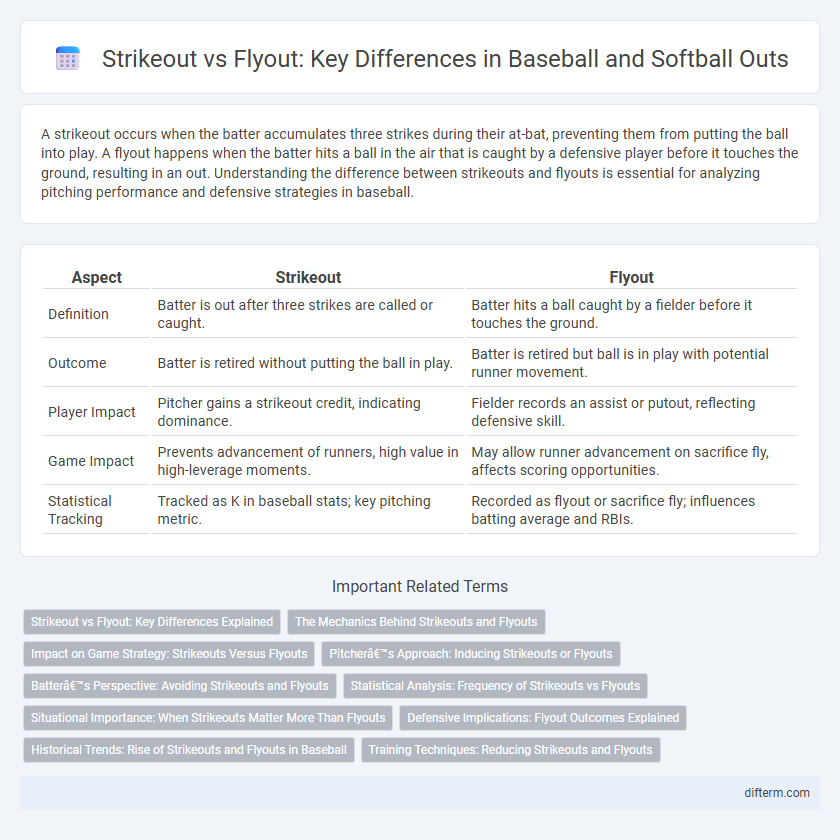A strikeout occurs when the batter accumulates three strikes during their at-bat, preventing them from putting the ball into play. A flyout happens when the batter hits a ball in the air that is caught by a defensive player before it touches the ground, resulting in an out. Understanding the difference between strikeouts and flyouts is essential for analyzing pitching performance and defensive strategies in baseball.
Table of Comparison
| Aspect | Strikeout | Flyout |
|---|---|---|
| Definition | Batter is out after three strikes are called or caught. | Batter hits a ball caught by a fielder before it touches the ground. |
| Outcome | Batter is retired without putting the ball in play. | Batter is retired but ball is in play with potential runner movement. |
| Player Impact | Pitcher gains a strikeout credit, indicating dominance. | Fielder records an assist or putout, reflecting defensive skill. |
| Game Impact | Prevents advancement of runners, high value in high-leverage moments. | May allow runner advancement on sacrifice fly, affects scoring opportunities. |
| Statistical Tracking | Tracked as K in baseball stats; key pitching metric. | Recorded as flyout or sacrifice fly; influences batting average and RBIs. |
Strikeout vs Flyout: Key Differences Explained
Strikeouts occur when a batter accumulates three strikes during their at-bat, resulting in an automatic out without the ball being put into play, emphasizing the pitcher's dominance and precision. Flyouts happen when a batter hits a ball that is caught in the air by a defensive player, showcasing fielders' agility and coordination. The fundamental difference lies in a strikeout's reliance on pitching skill to prevent contact versus a flyout requiring effective ballputting followed by defensive catching.
The Mechanics Behind Strikeouts and Flyouts
Strikeouts occur when a pitcher delivers three strikes to a batter, relying on precise pitch location, velocity, and movement to outwit the hitter's timing and swing mechanics. Flyouts result from a batter making contact but hitting the ball into the air, where defensive players use positioning and tracking skills to catch the ball before it lands, ending the at-bat. Understanding the biomechanics of the pitcher's release and the batter's swing angle reveals how the tug-of-war between control and contact determines strikeouts versus flyouts.
Impact on Game Strategy: Strikeouts Versus Flyouts
Strikeouts eliminate any chance for the batter to advance or put the ball in play, which can prevent scoring opportunities and force teams to rely heavily on pitching and defense. Flyouts, while resulting in outs, may allow runners to tag up and advance bases, creating strategic decisions for both offense and defense in managing baserunner positioning. Managers often weigh the value of aggressive pitching for strikeouts against the risk of flyouts that might enable run-scoring plays or sacrifice fly opportunities.
Pitcher’s Approach: Inducing Strikeouts or Flyouts
Pitchers adopt distinct approaches to induce strikeouts or flyouts, focusing on pitch velocity, movement, and placement. Strikeout pitchers rely on high-velocity fastballs and sharp breaking balls to overpower hitters and reduce contact. Flyout-oriented pitchers emphasize inducing weak contact through off-speed pitches and locating the ball in the upper or outer parts of the strike zone.
Batter’s Perspective: Avoiding Strikeouts and Flyouts
Batters aiming to avoid strikeouts focus on improving pitch recognition and timing to make consistent contact with the ball. Emphasizing bat control and situational awareness helps reduce flyouts by adjusting swing trajectory to keep the ball in play. Effective plate discipline combined with strategic hitting increases the likelihood of reaching base and advancing runners.
Statistical Analysis: Frequency of Strikeouts vs Flyouts
Strikeouts occur more frequently in Major League Baseball, averaging approximately 8.8 per nine innings, compared to flyouts, which average around 5.4 per nine innings. Statistical analysis shows pitchers with higher strikeout rates often dominate by generating swings and misses, while flyouts tend to indicate contact resulting in airborne outs. Teams emphasize strikeout metrics to evaluate pitching effectiveness and predict game outcomes due to their impact on limiting offensive opportunities.
Situational Importance: When Strikeouts Matter More Than Flyouts
In baseball, strikeouts hold greater situational importance than flyouts during high-leverage innings, especially with runners in scoring position or bases loaded, as they prevent any possibility of advancing runners. Pitchers rely on strikeouts to minimize defensive errors and double plays that could occur on flyouts, making strikeouts critical in late-game control situations. Statistical analysis shows that teams with higher strikeout rates in clutch moments significantly reduce opponents' scoring opportunities compared to relying on flyouts.
Defensive Implications: Flyout Outcomes Explained
Flyouts serve as crucial defensive plays by allowing the outfielder to control base runners and prevent extra bases, thus limiting opponent scoring opportunities. Unlike strikeouts, which halt batting momentum without ball-in-play risk, flyouts provide fielders chances to execute strategic throws and double plays. Effective flyout management improves team fielding statistics and preserves defensive positioning during high-pressure innings.
Historical Trends: Rise of Strikeouts and Flyouts in Baseball
Strikeouts have steadily increased in Major League Baseball, rising from an average of 3.4 per game in the 1980s to over 8 in recent seasons, reflecting a shift toward power pitching and emphasis on velocity. Flyouts have also seen a rise, correlating with the "launch angle" revolution that encourages hitters to elevate the ball for home runs, driving flyball rates up by nearly 20% over the past decade. Historical data illustrates how these trends signify a strategic transformation emphasizing strikeouts and flyouts as dominant methods of ending at-bats.
Training Techniques: Reducing Strikeouts and Flyouts
Effective training techniques to reduce strikeouts and flyouts emphasize precise pitch recognition drills and swing mechanics adjustments, improving batter reaction time and contact quality. Incorporating video analysis and situational batting practice helps hitters anticipate pitch types and locations, enhancing plate discipline and decision-making. Strength and flexibility exercises tailored to batting also contribute to optimized swing path and power, decreasing the frequency of weak flyouts and missed strikes.
strikeout vs flyout Infographic

 difterm.com
difterm.com